Management Report: Contemporary Labor Market and Workforce Planning
VerifiedAdded on 2023/04/19
|30
|6417
|285
Report
AI Summary
This report provides a comprehensive analysis of management principles related to resourcing and talent planning. It begins by examining contemporary labor market trends in the UK and Kuwait, including the impact of de-industrialization, the rise of the service sector, and the influence of the National Minimum Wage. The report then explores strategic positioning in the competitive labor market and the significance of tight and loose labor market conditions. The second part of the report delves into the roles of government, employers, and trade unions in meeting future skill needs, followed by a discussion of effective workforce planning principles and tools. Furthermore, the report covers succession and career development plans, contributions to organizational downsizing, and the development of job descriptions and competency frameworks. The report also examines legal requirements in recruitment and selection, evaluates recruitment methods, and analyzes factors affecting employee turnover. Finally, the report provides guidance on managing dismissal, retirement, and redundancies, ensuring good and lawful practices.
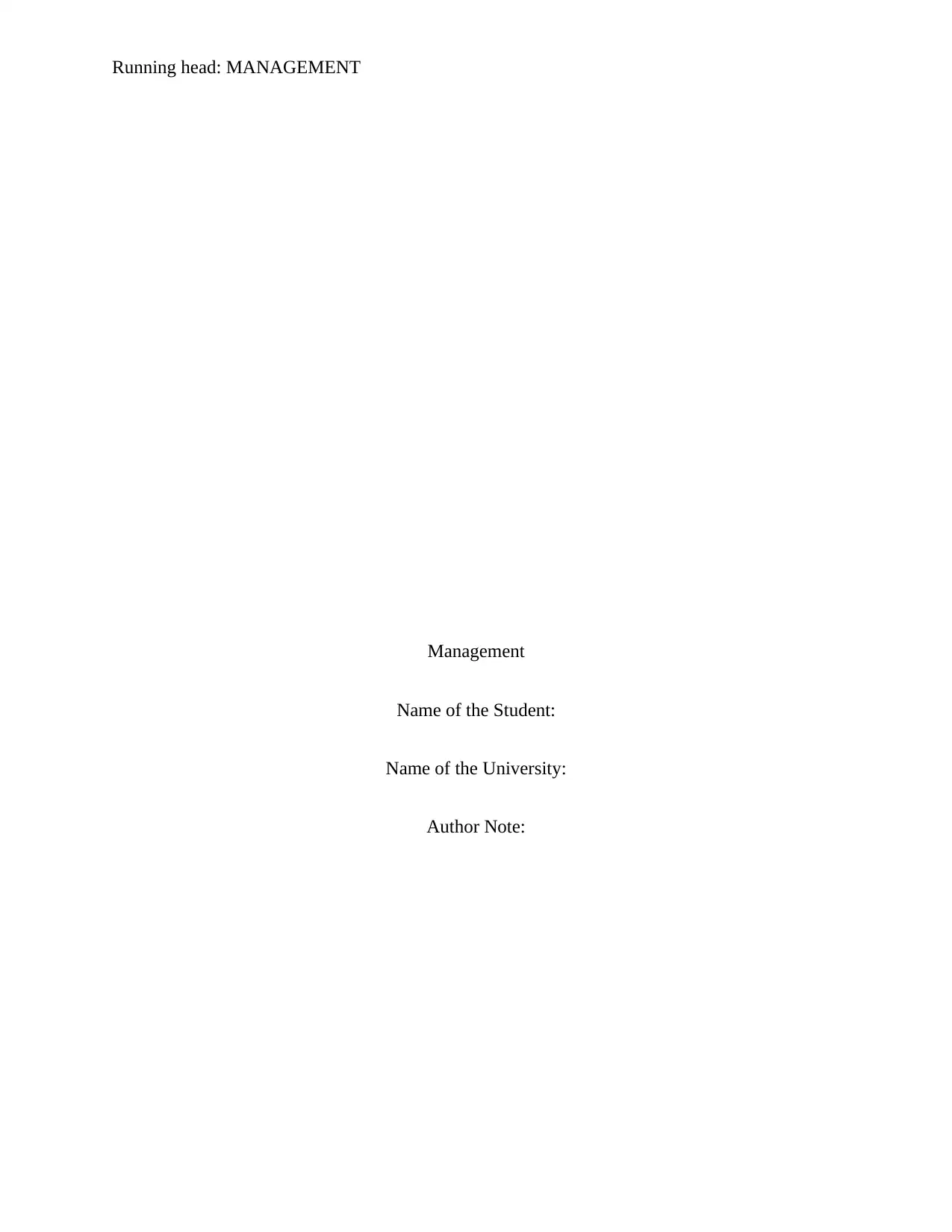
Running head: MANAGEMENT
Management
Name of the Student:
Name of the University:
Author Note:
Management
Name of the Student:
Name of the University:
Author Note:
Paraphrase This Document
Need a fresh take? Get an instant paraphrase of this document with our AI Paraphraser
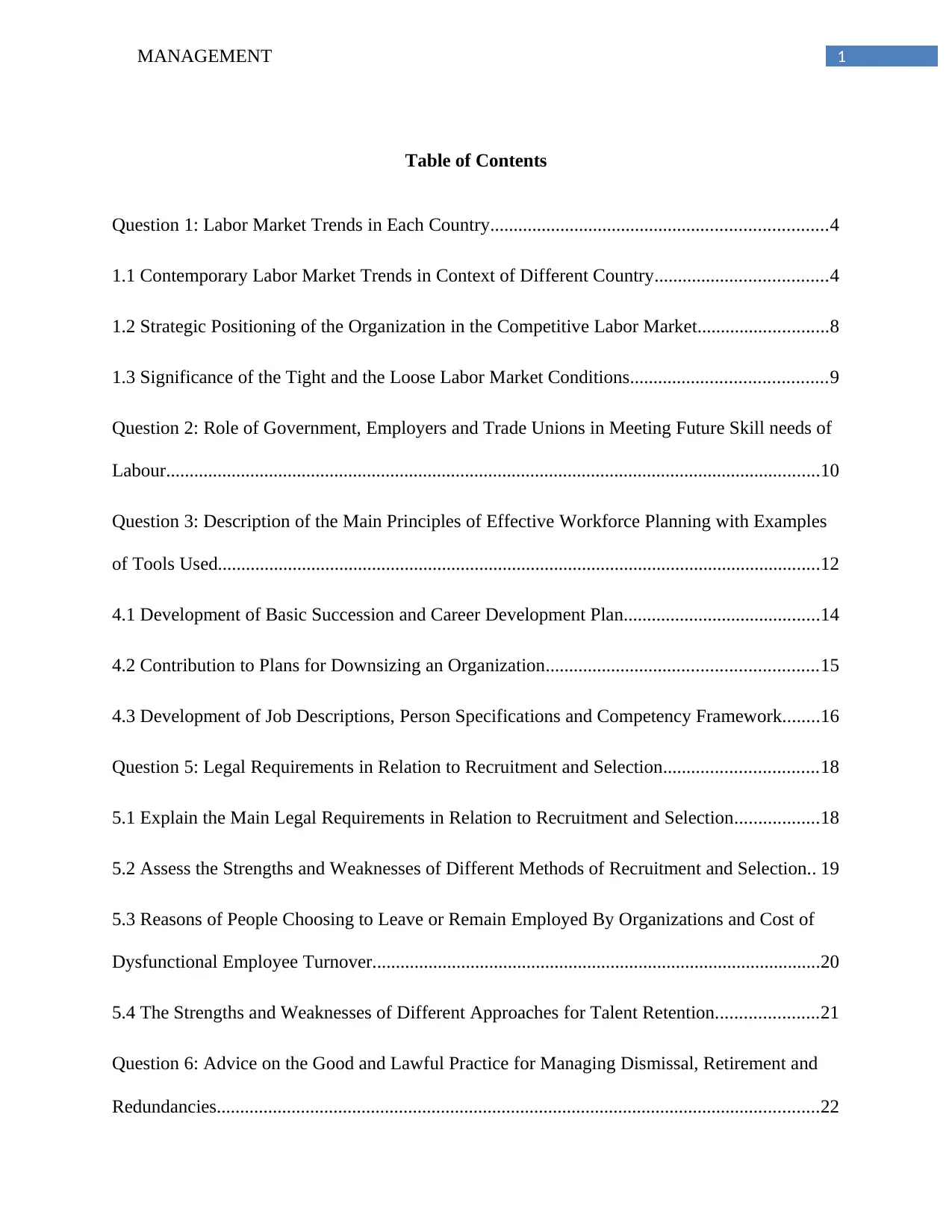
1MANAGEMENT
Table of Contents
Question 1: Labor Market Trends in Each Country........................................................................4
1.1 Contemporary Labor Market Trends in Context of Different Country.....................................4
1.2 Strategic Positioning of the Organization in the Competitive Labor Market............................8
1.3 Significance of the Tight and the Loose Labor Market Conditions..........................................9
Question 2: Role of Government, Employers and Trade Unions in Meeting Future Skill needs of
Labour............................................................................................................................................10
Question 3: Description of the Main Principles of Effective Workforce Planning with Examples
of Tools Used.................................................................................................................................12
4.1 Development of Basic Succession and Career Development Plan..........................................14
4.2 Contribution to Plans for Downsizing an Organization..........................................................15
4.3 Development of Job Descriptions, Person Specifications and Competency Framework........16
Question 5: Legal Requirements in Relation to Recruitment and Selection.................................18
5.1 Explain the Main Legal Requirements in Relation to Recruitment and Selection..................18
5.2 Assess the Strengths and Weaknesses of Different Methods of Recruitment and Selection.. 19
5.3 Reasons of People Choosing to Leave or Remain Employed By Organizations and Cost of
Dysfunctional Employee Turnover................................................................................................20
5.4 The Strengths and Weaknesses of Different Approaches for Talent Retention......................21
Question 6: Advice on the Good and Lawful Practice for Managing Dismissal, Retirement and
Redundancies.................................................................................................................................22
Table of Contents
Question 1: Labor Market Trends in Each Country........................................................................4
1.1 Contemporary Labor Market Trends in Context of Different Country.....................................4
1.2 Strategic Positioning of the Organization in the Competitive Labor Market............................8
1.3 Significance of the Tight and the Loose Labor Market Conditions..........................................9
Question 2: Role of Government, Employers and Trade Unions in Meeting Future Skill needs of
Labour............................................................................................................................................10
Question 3: Description of the Main Principles of Effective Workforce Planning with Examples
of Tools Used.................................................................................................................................12
4.1 Development of Basic Succession and Career Development Plan..........................................14
4.2 Contribution to Plans for Downsizing an Organization..........................................................15
4.3 Development of Job Descriptions, Person Specifications and Competency Framework........16
Question 5: Legal Requirements in Relation to Recruitment and Selection.................................18
5.1 Explain the Main Legal Requirements in Relation to Recruitment and Selection..................18
5.2 Assess the Strengths and Weaknesses of Different Methods of Recruitment and Selection.. 19
5.3 Reasons of People Choosing to Leave or Remain Employed By Organizations and Cost of
Dysfunctional Employee Turnover................................................................................................20
5.4 The Strengths and Weaknesses of Different Approaches for Talent Retention......................21
Question 6: Advice on the Good and Lawful Practice for Managing Dismissal, Retirement and
Redundancies.................................................................................................................................22
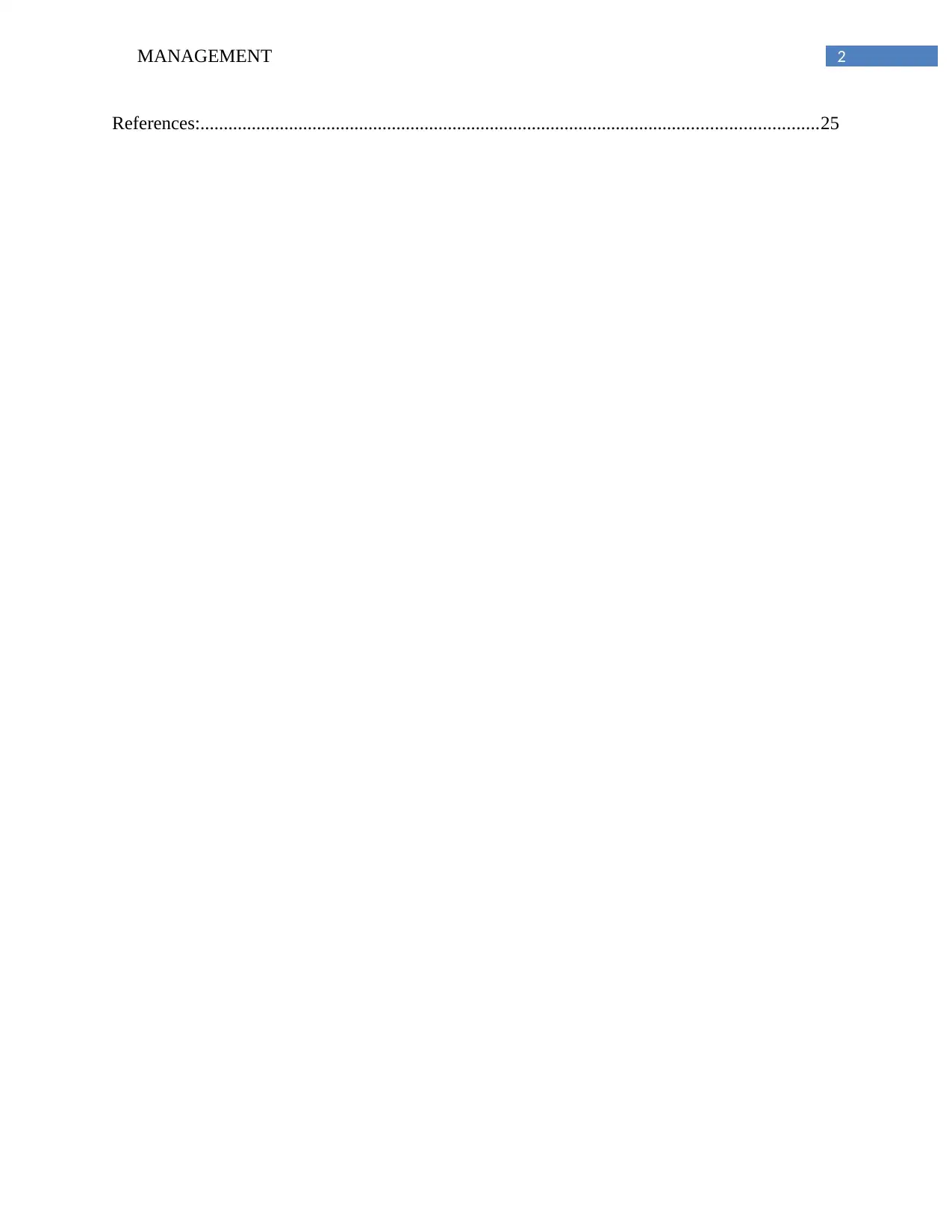
2MANAGEMENT
References:....................................................................................................................................25
References:....................................................................................................................................25
⊘ This is a preview!⊘
Do you want full access?
Subscribe today to unlock all pages.

Trusted by 1+ million students worldwide
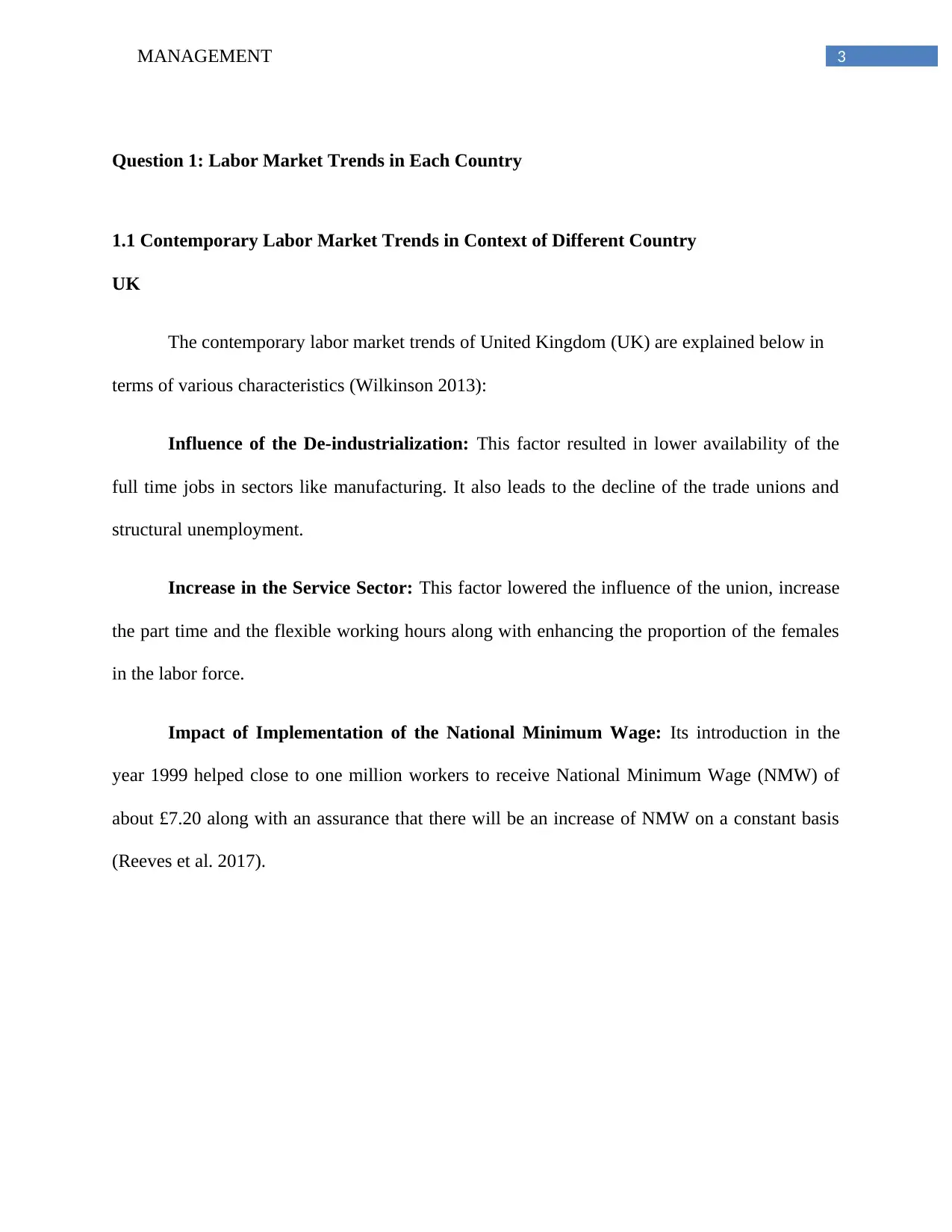
3MANAGEMENT
Question 1: Labor Market Trends in Each Country
1.1 Contemporary Labor Market Trends in Context of Different Country
UK
The contemporary labor market trends of United Kingdom (UK) are explained below in
terms of various characteristics (Wilkinson 2013):
Influence of the De-industrialization: This factor resulted in lower availability of the
full time jobs in sectors like manufacturing. It also leads to the decline of the trade unions and
structural unemployment.
Increase in the Service Sector: This factor lowered the influence of the union, increase
the part time and the flexible working hours along with enhancing the proportion of the females
in the labor force.
Impact of Implementation of the National Minimum Wage: Its introduction in the
year 1999 helped close to one million workers to receive National Minimum Wage (NMW) of
about £7.20 along with an assurance that there will be an increase of NMW on a constant basis
(Reeves et al. 2017).
Question 1: Labor Market Trends in Each Country
1.1 Contemporary Labor Market Trends in Context of Different Country
UK
The contemporary labor market trends of United Kingdom (UK) are explained below in
terms of various characteristics (Wilkinson 2013):
Influence of the De-industrialization: This factor resulted in lower availability of the
full time jobs in sectors like manufacturing. It also leads to the decline of the trade unions and
structural unemployment.
Increase in the Service Sector: This factor lowered the influence of the union, increase
the part time and the flexible working hours along with enhancing the proportion of the females
in the labor force.
Impact of Implementation of the National Minimum Wage: Its introduction in the
year 1999 helped close to one million workers to receive National Minimum Wage (NMW) of
about £7.20 along with an assurance that there will be an increase of NMW on a constant basis
(Reeves et al. 2017).
Paraphrase This Document
Need a fresh take? Get an instant paraphrase of this document with our AI Paraphraser
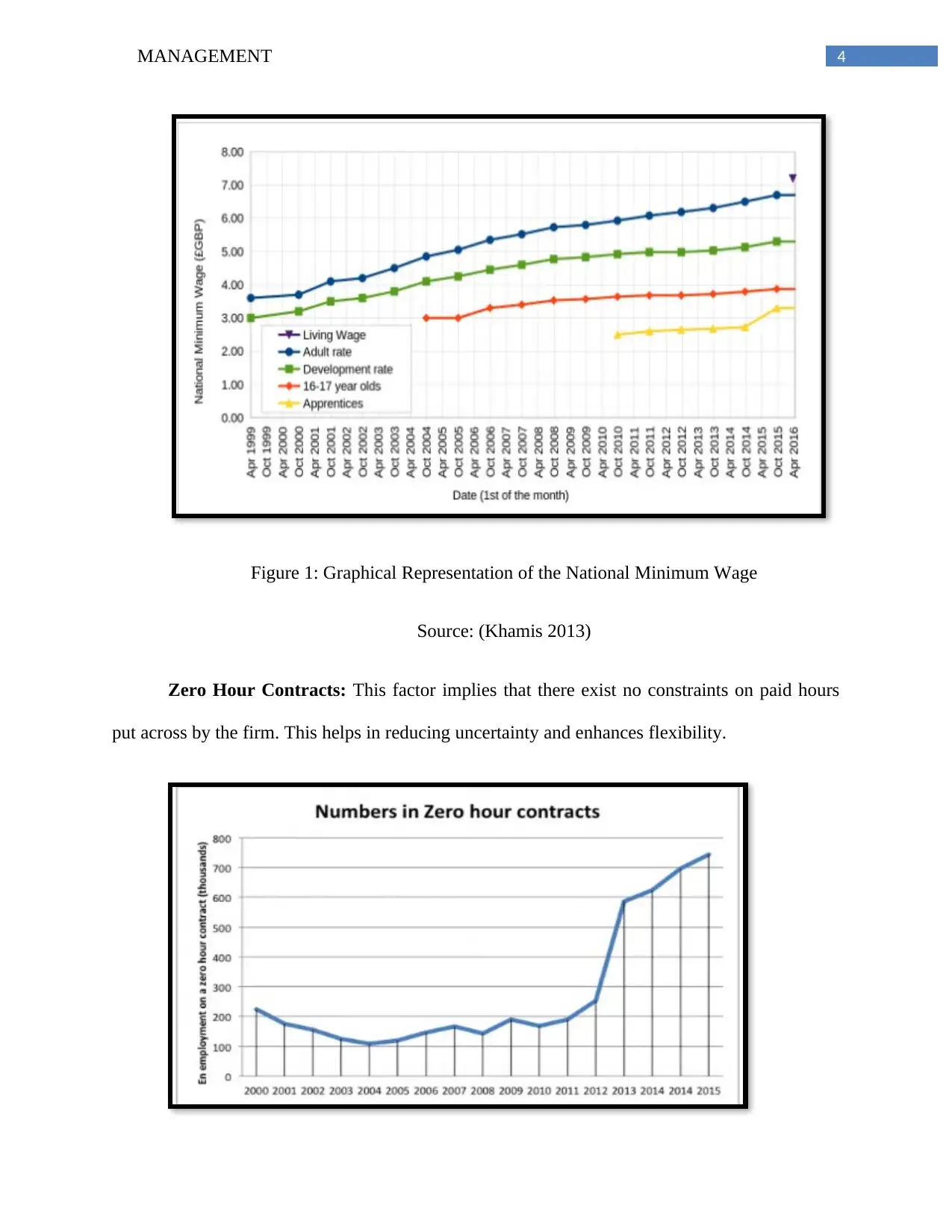
4MANAGEMENT
Figure 1: Graphical Representation of the National Minimum Wage
Source: (Khamis 2013)
Zero Hour Contracts: This factor implies that there exist no constraints on paid hours
put across by the firm. This helps in reducing uncertainty and enhances flexibility.
Figure 1: Graphical Representation of the National Minimum Wage
Source: (Khamis 2013)
Zero Hour Contracts: This factor implies that there exist no constraints on paid hours
put across by the firm. This helps in reducing uncertainty and enhances flexibility.
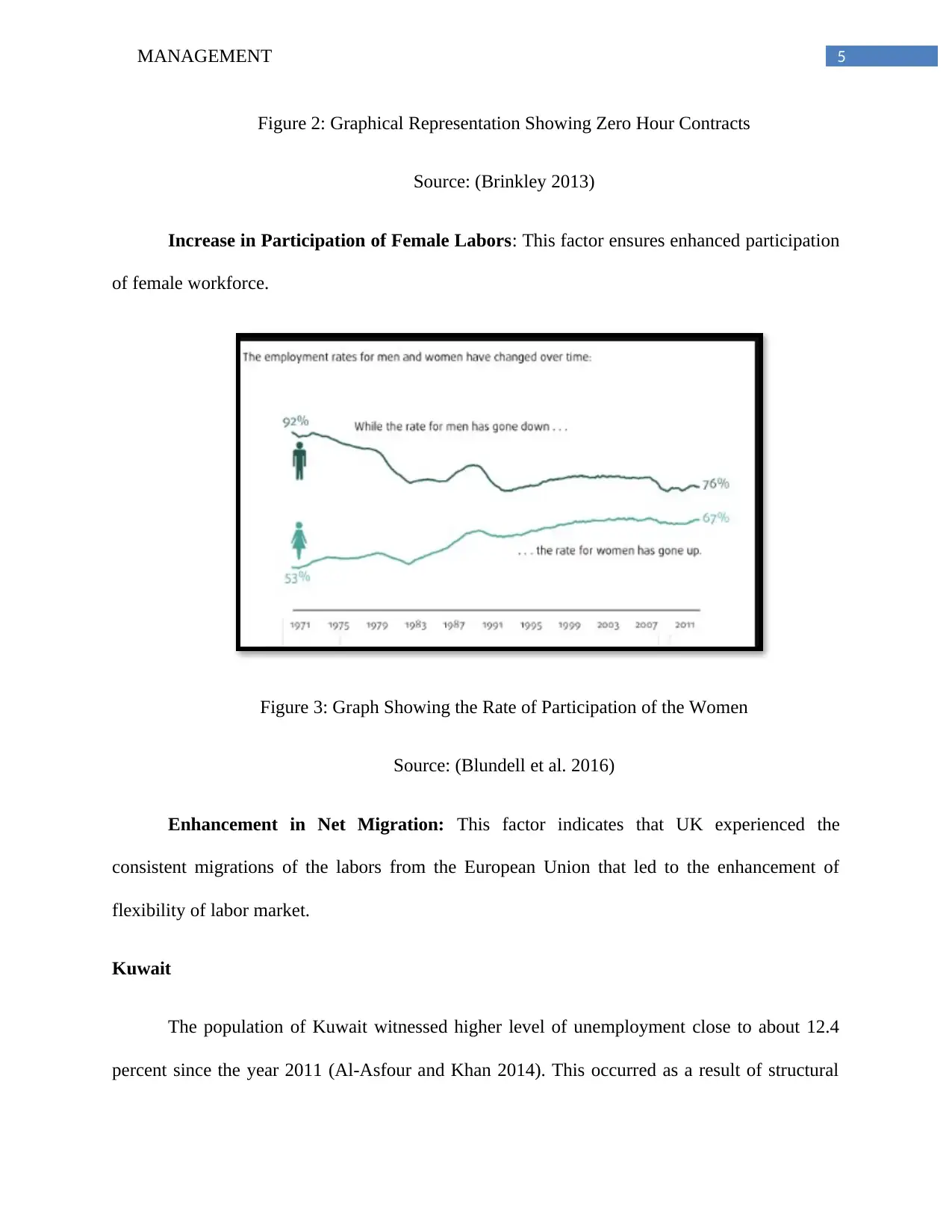
5MANAGEMENT
Figure 2: Graphical Representation Showing Zero Hour Contracts
Source: (Brinkley 2013)
Increase in Participation of Female Labors: This factor ensures enhanced participation
of female workforce.
Figure 3: Graph Showing the Rate of Participation of the Women
Source: (Blundell et al. 2016)
Enhancement in Net Migration: This factor indicates that UK experienced the
consistent migrations of the labors from the European Union that led to the enhancement of
flexibility of labor market.
Kuwait
The population of Kuwait witnessed higher level of unemployment close to about 12.4
percent since the year 2011 (Al-Asfour and Khan 2014). This occurred as a result of structural
Figure 2: Graphical Representation Showing Zero Hour Contracts
Source: (Brinkley 2013)
Increase in Participation of Female Labors: This factor ensures enhanced participation
of female workforce.
Figure 3: Graph Showing the Rate of Participation of the Women
Source: (Blundell et al. 2016)
Enhancement in Net Migration: This factor indicates that UK experienced the
consistent migrations of the labors from the European Union that led to the enhancement of
flexibility of labor market.
Kuwait
The population of Kuwait witnessed higher level of unemployment close to about 12.4
percent since the year 2011 (Al-Asfour and Khan 2014). This occurred as a result of structural
⊘ This is a preview!⊘
Do you want full access?
Subscribe today to unlock all pages.

Trusted by 1+ million students worldwide
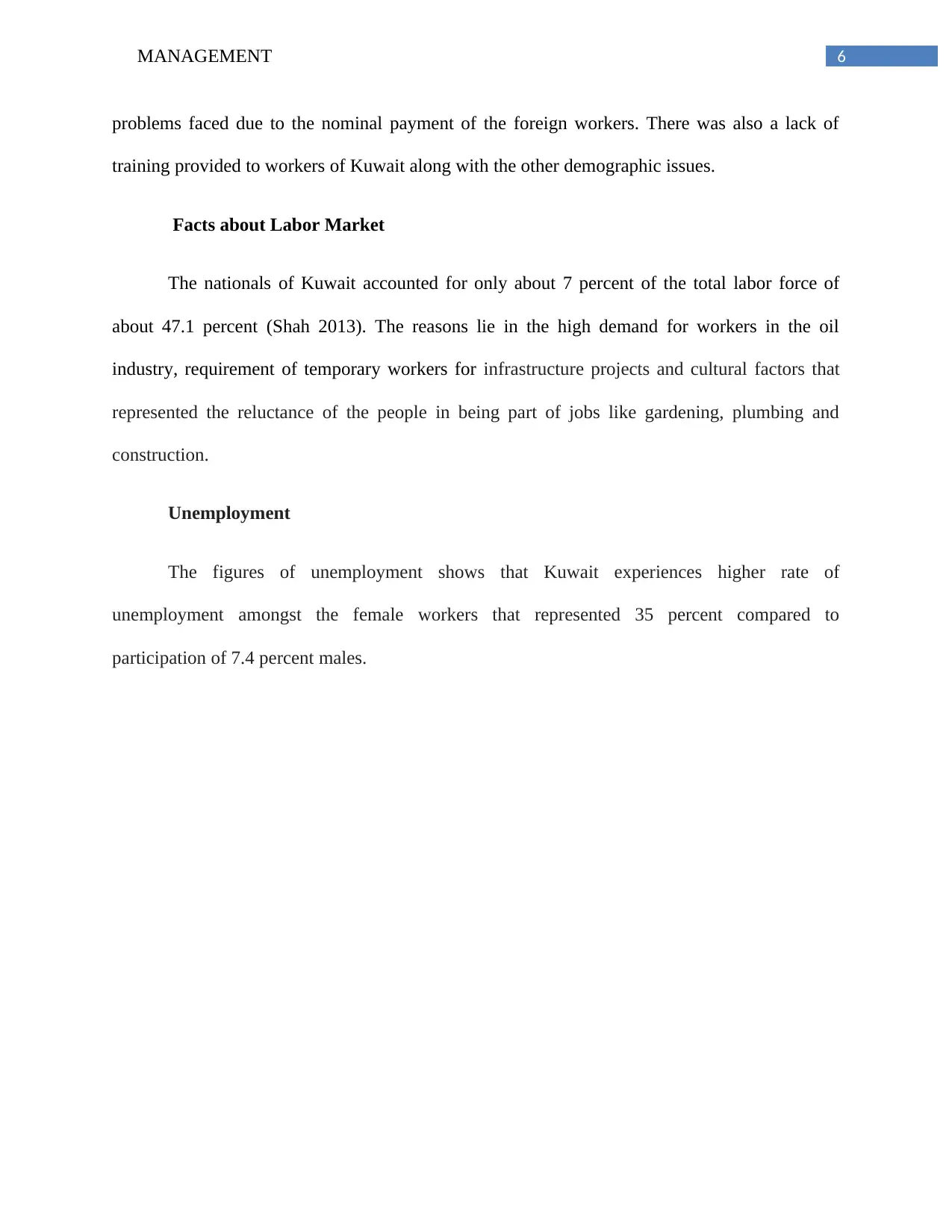
6MANAGEMENT
problems faced due to the nominal payment of the foreign workers. There was also a lack of
training provided to workers of Kuwait along with the other demographic issues.
Facts about Labor Market
The nationals of Kuwait accounted for only about 7 percent of the total labor force of
about 47.1 percent (Shah 2013). The reasons lie in the high demand for workers in the oil
industry, requirement of temporary workers for infrastructure projects and cultural factors that
represented the reluctance of the people in being part of jobs like gardening, plumbing and
construction.
Unemployment
The figures of unemployment shows that Kuwait experiences higher rate of
unemployment amongst the female workers that represented 35 percent compared to
participation of 7.4 percent males.
problems faced due to the nominal payment of the foreign workers. There was also a lack of
training provided to workers of Kuwait along with the other demographic issues.
Facts about Labor Market
The nationals of Kuwait accounted for only about 7 percent of the total labor force of
about 47.1 percent (Shah 2013). The reasons lie in the high demand for workers in the oil
industry, requirement of temporary workers for infrastructure projects and cultural factors that
represented the reluctance of the people in being part of jobs like gardening, plumbing and
construction.
Unemployment
The figures of unemployment shows that Kuwait experiences higher rate of
unemployment amongst the female workers that represented 35 percent compared to
participation of 7.4 percent males.
Paraphrase This Document
Need a fresh take? Get an instant paraphrase of this document with our AI Paraphraser
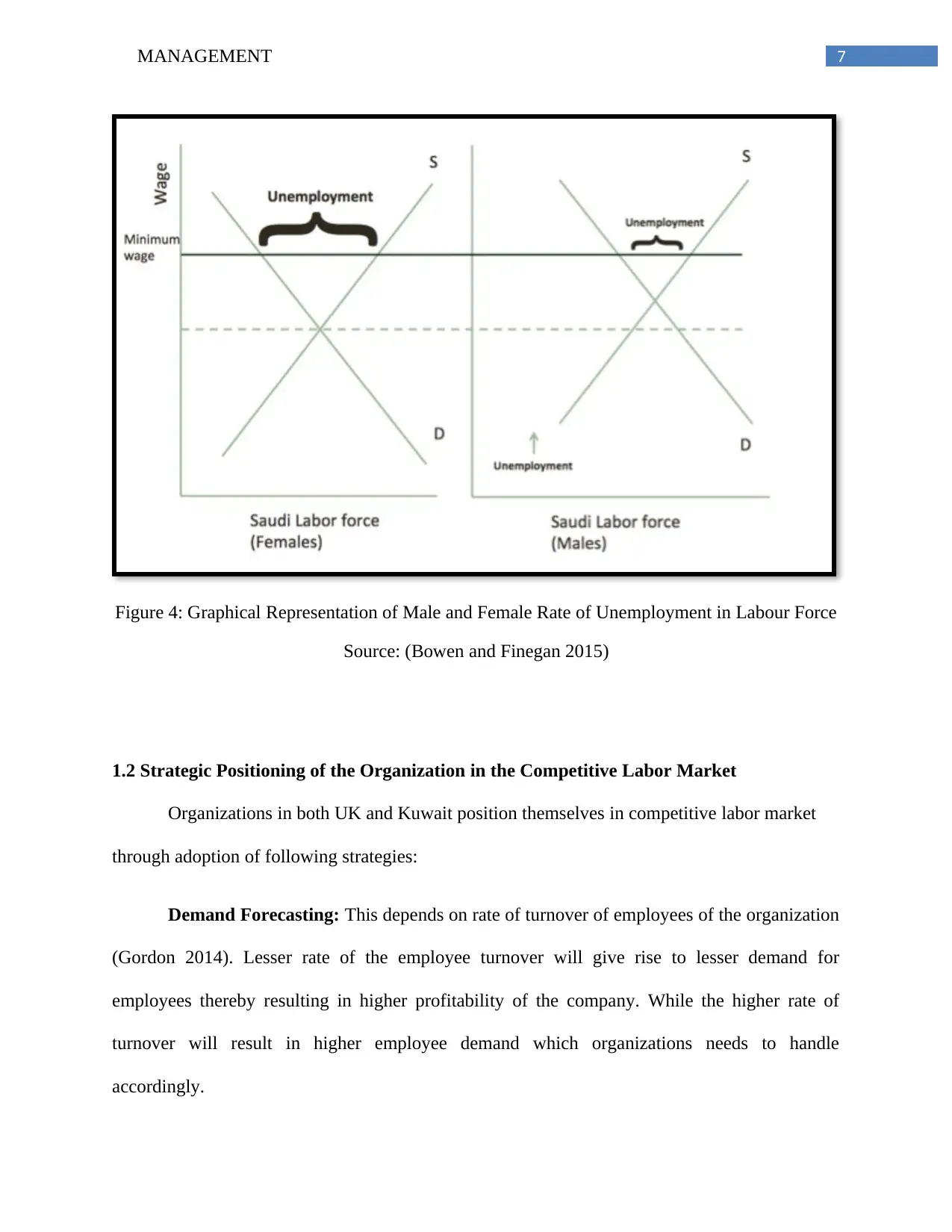
7MANAGEMENT
Figure 4: Graphical Representation of Male and Female Rate of Unemployment in Labour Force
Source: (Bowen and Finegan 2015)
1.2 Strategic Positioning of the Organization in the Competitive Labor Market
Organizations in both UK and Kuwait position themselves in competitive labor market
through adoption of following strategies:
Demand Forecasting: This depends on rate of turnover of employees of the organization
(Gordon 2014). Lesser rate of the employee turnover will give rise to lesser demand for
employees thereby resulting in higher profitability of the company. While the higher rate of
turnover will result in higher employee demand which organizations needs to handle
accordingly.
Figure 4: Graphical Representation of Male and Female Rate of Unemployment in Labour Force
Source: (Bowen and Finegan 2015)
1.2 Strategic Positioning of the Organization in the Competitive Labor Market
Organizations in both UK and Kuwait position themselves in competitive labor market
through adoption of following strategies:
Demand Forecasting: This depends on rate of turnover of employees of the organization
(Gordon 2014). Lesser rate of the employee turnover will give rise to lesser demand for
employees thereby resulting in higher profitability of the company. While the higher rate of
turnover will result in higher employee demand which organizations needs to handle
accordingly.
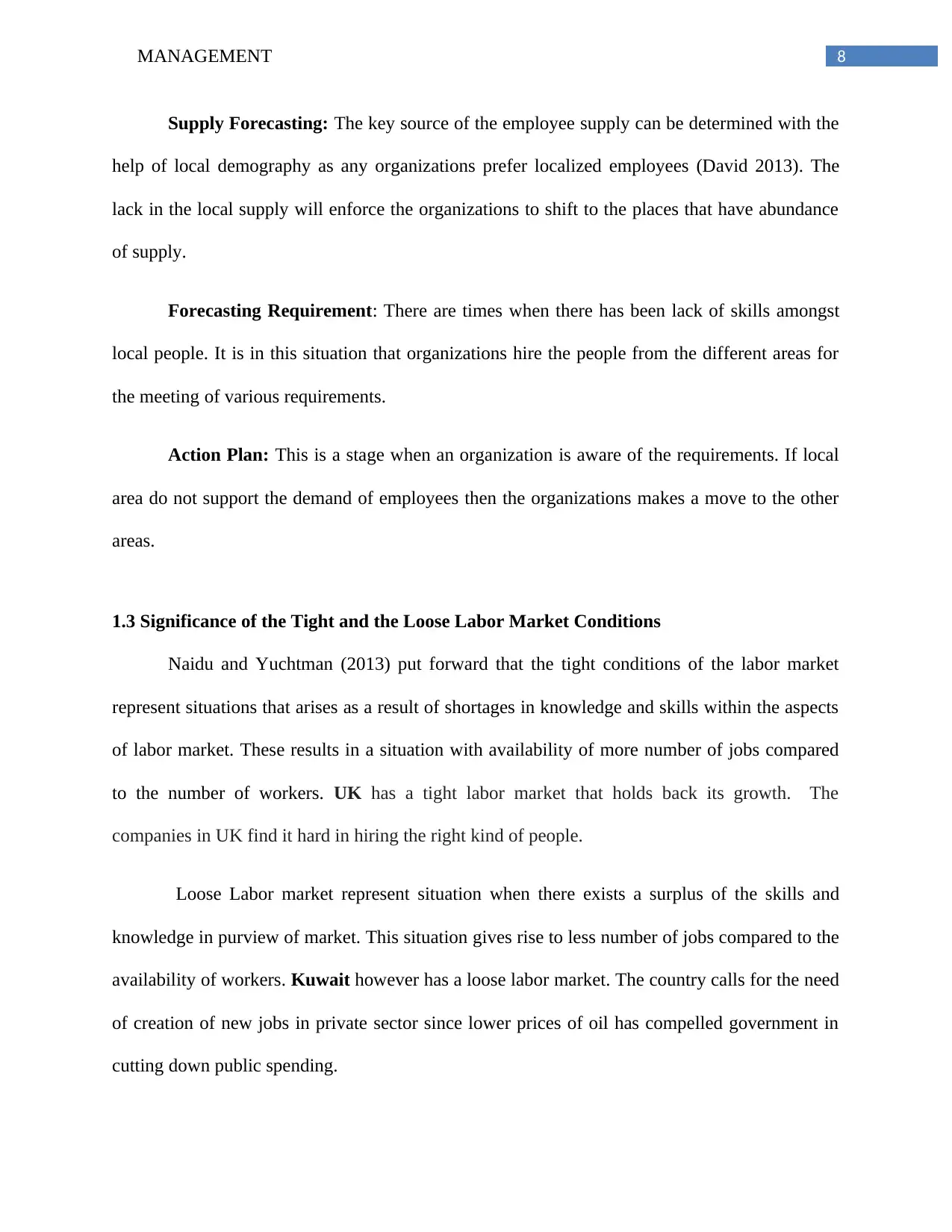
8MANAGEMENT
Supply Forecasting: The key source of the employee supply can be determined with the
help of local demography as any organizations prefer localized employees (David 2013). The
lack in the local supply will enforce the organizations to shift to the places that have abundance
of supply.
Forecasting Requirement: There are times when there has been lack of skills amongst
local people. It is in this situation that organizations hire the people from the different areas for
the meeting of various requirements.
Action Plan: This is a stage when an organization is aware of the requirements. If local
area do not support the demand of employees then the organizations makes a move to the other
areas.
1.3 Significance of the Tight and the Loose Labor Market Conditions
Naidu and Yuchtman (2013) put forward that the tight conditions of the labor market
represent situations that arises as a result of shortages in knowledge and skills within the aspects
of labor market. These results in a situation with availability of more number of jobs compared
to the number of workers. UK has a tight labor market that holds back its growth. The
companies in UK find it hard in hiring the right kind of people.
Loose Labor market represent situation when there exists a surplus of the skills and
knowledge in purview of market. This situation gives rise to less number of jobs compared to the
availability of workers. Kuwait however has a loose labor market. The country calls for the need
of creation of new jobs in private sector since lower prices of oil has compelled government in
cutting down public spending.
Supply Forecasting: The key source of the employee supply can be determined with the
help of local demography as any organizations prefer localized employees (David 2013). The
lack in the local supply will enforce the organizations to shift to the places that have abundance
of supply.
Forecasting Requirement: There are times when there has been lack of skills amongst
local people. It is in this situation that organizations hire the people from the different areas for
the meeting of various requirements.
Action Plan: This is a stage when an organization is aware of the requirements. If local
area do not support the demand of employees then the organizations makes a move to the other
areas.
1.3 Significance of the Tight and the Loose Labor Market Conditions
Naidu and Yuchtman (2013) put forward that the tight conditions of the labor market
represent situations that arises as a result of shortages in knowledge and skills within the aspects
of labor market. These results in a situation with availability of more number of jobs compared
to the number of workers. UK has a tight labor market that holds back its growth. The
companies in UK find it hard in hiring the right kind of people.
Loose Labor market represent situation when there exists a surplus of the skills and
knowledge in purview of market. This situation gives rise to less number of jobs compared to the
availability of workers. Kuwait however has a loose labor market. The country calls for the need
of creation of new jobs in private sector since lower prices of oil has compelled government in
cutting down public spending.
⊘ This is a preview!⊘
Do you want full access?
Subscribe today to unlock all pages.

Trusted by 1+ million students worldwide
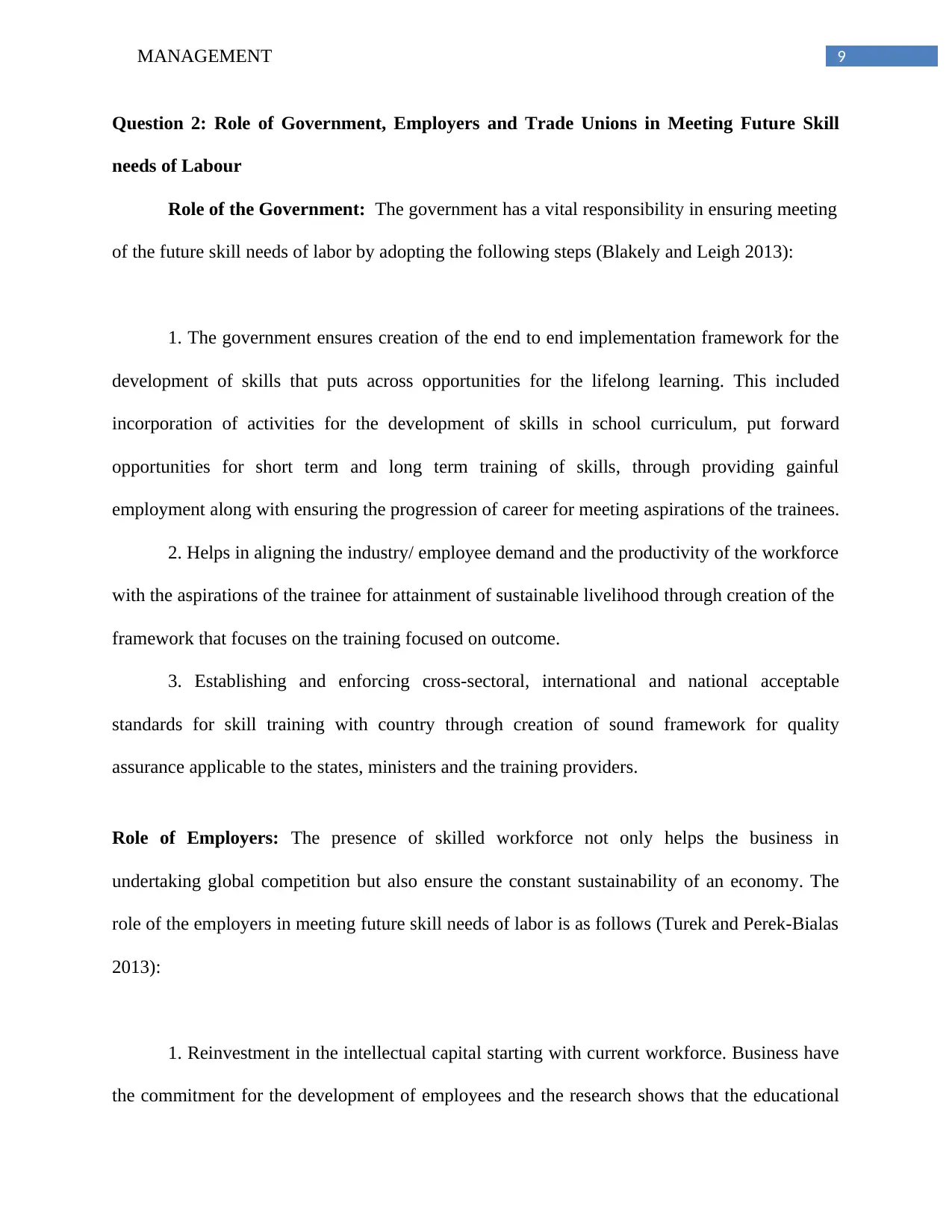
9MANAGEMENT
Question 2: Role of Government, Employers and Trade Unions in Meeting Future Skill
needs of Labour
Role of the Government: The government has a vital responsibility in ensuring meeting
of the future skill needs of labor by adopting the following steps (Blakely and Leigh 2013):
1. The government ensures creation of the end to end implementation framework for the
development of skills that puts across opportunities for the lifelong learning. This included
incorporation of activities for the development of skills in school curriculum, put forward
opportunities for short term and long term training of skills, through providing gainful
employment along with ensuring the progression of career for meeting aspirations of the trainees.
2. Helps in aligning the industry/ employee demand and the productivity of the workforce
with the aspirations of the trainee for attainment of sustainable livelihood through creation of the
framework that focuses on the training focused on outcome.
3. Establishing and enforcing cross-sectoral, international and national acceptable
standards for skill training with country through creation of sound framework for quality
assurance applicable to the states, ministers and the training providers.
Role of Employers: The presence of skilled workforce not only helps the business in
undertaking global competition but also ensure the constant sustainability of an economy. The
role of the employers in meeting future skill needs of labor is as follows (Turek and Perek-Bialas
2013):
1. Reinvestment in the intellectual capital starting with current workforce. Business have
the commitment for the development of employees and the research shows that the educational
Question 2: Role of Government, Employers and Trade Unions in Meeting Future Skill
needs of Labour
Role of the Government: The government has a vital responsibility in ensuring meeting
of the future skill needs of labor by adopting the following steps (Blakely and Leigh 2013):
1. The government ensures creation of the end to end implementation framework for the
development of skills that puts across opportunities for the lifelong learning. This included
incorporation of activities for the development of skills in school curriculum, put forward
opportunities for short term and long term training of skills, through providing gainful
employment along with ensuring the progression of career for meeting aspirations of the trainees.
2. Helps in aligning the industry/ employee demand and the productivity of the workforce
with the aspirations of the trainee for attainment of sustainable livelihood through creation of the
framework that focuses on the training focused on outcome.
3. Establishing and enforcing cross-sectoral, international and national acceptable
standards for skill training with country through creation of sound framework for quality
assurance applicable to the states, ministers and the training providers.
Role of Employers: The presence of skilled workforce not only helps the business in
undertaking global competition but also ensure the constant sustainability of an economy. The
role of the employers in meeting future skill needs of labor is as follows (Turek and Perek-Bialas
2013):
1. Reinvestment in the intellectual capital starting with current workforce. Business have
the commitment for the development of employees and the research shows that the educational
Paraphrase This Document
Need a fresh take? Get an instant paraphrase of this document with our AI Paraphraser
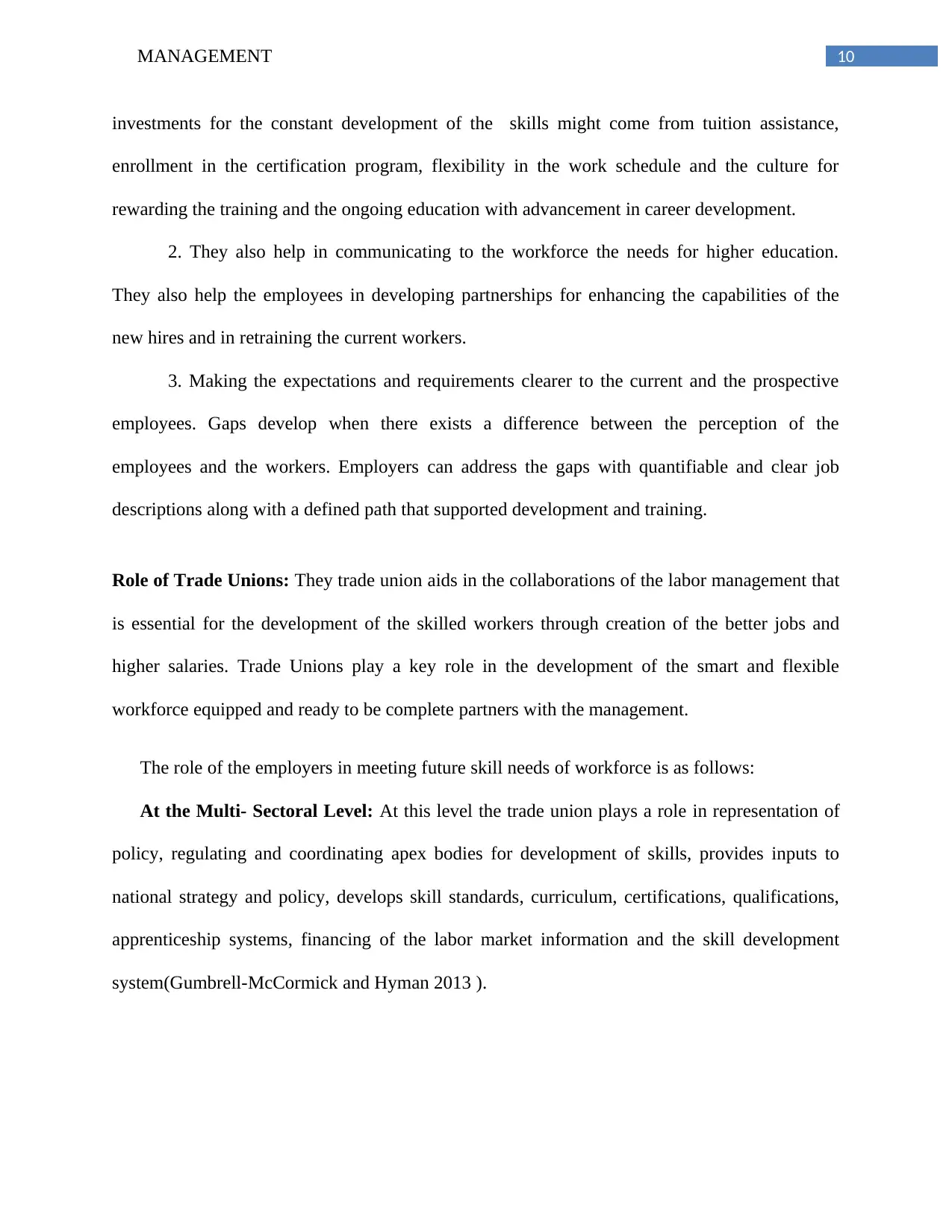
10MANAGEMENT
investments for the constant development of the skills might come from tuition assistance,
enrollment in the certification program, flexibility in the work schedule and the culture for
rewarding the training and the ongoing education with advancement in career development.
2. They also help in communicating to the workforce the needs for higher education.
They also help the employees in developing partnerships for enhancing the capabilities of the
new hires and in retraining the current workers.
3. Making the expectations and requirements clearer to the current and the prospective
employees. Gaps develop when there exists a difference between the perception of the
employees and the workers. Employers can address the gaps with quantifiable and clear job
descriptions along with a defined path that supported development and training.
Role of Trade Unions: They trade union aids in the collaborations of the labor management that
is essential for the development of the skilled workers through creation of the better jobs and
higher salaries. Trade Unions play a key role in the development of the smart and flexible
workforce equipped and ready to be complete partners with the management.
The role of the employers in meeting future skill needs of workforce is as follows:
At the Multi- Sectoral Level: At this level the trade union plays a role in representation of
policy, regulating and coordinating apex bodies for development of skills, provides inputs to
national strategy and policy, develops skill standards, curriculum, certifications, qualifications,
apprenticeship systems, financing of the labor market information and the skill development
system(Gumbrell-McCormick and Hyman 2013 ).
investments for the constant development of the skills might come from tuition assistance,
enrollment in the certification program, flexibility in the work schedule and the culture for
rewarding the training and the ongoing education with advancement in career development.
2. They also help in communicating to the workforce the needs for higher education.
They also help the employees in developing partnerships for enhancing the capabilities of the
new hires and in retraining the current workers.
3. Making the expectations and requirements clearer to the current and the prospective
employees. Gaps develop when there exists a difference between the perception of the
employees and the workers. Employers can address the gaps with quantifiable and clear job
descriptions along with a defined path that supported development and training.
Role of Trade Unions: They trade union aids in the collaborations of the labor management that
is essential for the development of the skilled workers through creation of the better jobs and
higher salaries. Trade Unions play a key role in the development of the smart and flexible
workforce equipped and ready to be complete partners with the management.
The role of the employers in meeting future skill needs of workforce is as follows:
At the Multi- Sectoral Level: At this level the trade union plays a role in representation of
policy, regulating and coordinating apex bodies for development of skills, provides inputs to
national strategy and policy, develops skill standards, curriculum, certifications, qualifications,
apprenticeship systems, financing of the labor market information and the skill development
system(Gumbrell-McCormick and Hyman 2013 ).
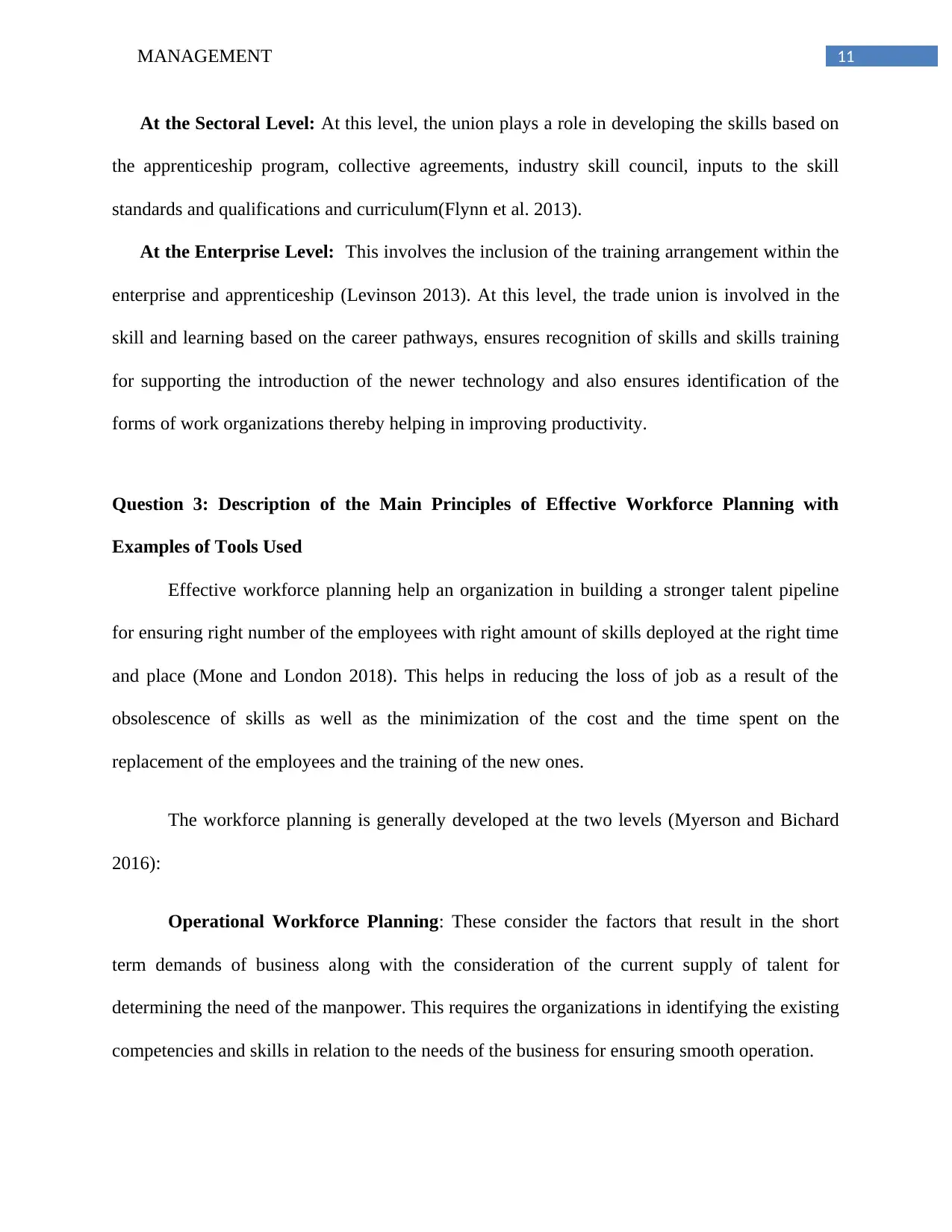
11MANAGEMENT
At the Sectoral Level: At this level, the union plays a role in developing the skills based on
the apprenticeship program, collective agreements, industry skill council, inputs to the skill
standards and qualifications and curriculum(Flynn et al. 2013).
At the Enterprise Level: This involves the inclusion of the training arrangement within the
enterprise and apprenticeship (Levinson 2013). At this level, the trade union is involved in the
skill and learning based on the career pathways, ensures recognition of skills and skills training
for supporting the introduction of the newer technology and also ensures identification of the
forms of work organizations thereby helping in improving productivity.
Question 3: Description of the Main Principles of Effective Workforce Planning with
Examples of Tools Used
Effective workforce planning help an organization in building a stronger talent pipeline
for ensuring right number of the employees with right amount of skills deployed at the right time
and place (Mone and London 2018). This helps in reducing the loss of job as a result of the
obsolescence of skills as well as the minimization of the cost and the time spent on the
replacement of the employees and the training of the new ones.
The workforce planning is generally developed at the two levels (Myerson and Bichard
2016):
Operational Workforce Planning: These consider the factors that result in the short
term demands of business along with the consideration of the current supply of talent for
determining the need of the manpower. This requires the organizations in identifying the existing
competencies and skills in relation to the needs of the business for ensuring smooth operation.
At the Sectoral Level: At this level, the union plays a role in developing the skills based on
the apprenticeship program, collective agreements, industry skill council, inputs to the skill
standards and qualifications and curriculum(Flynn et al. 2013).
At the Enterprise Level: This involves the inclusion of the training arrangement within the
enterprise and apprenticeship (Levinson 2013). At this level, the trade union is involved in the
skill and learning based on the career pathways, ensures recognition of skills and skills training
for supporting the introduction of the newer technology and also ensures identification of the
forms of work organizations thereby helping in improving productivity.
Question 3: Description of the Main Principles of Effective Workforce Planning with
Examples of Tools Used
Effective workforce planning help an organization in building a stronger talent pipeline
for ensuring right number of the employees with right amount of skills deployed at the right time
and place (Mone and London 2018). This helps in reducing the loss of job as a result of the
obsolescence of skills as well as the minimization of the cost and the time spent on the
replacement of the employees and the training of the new ones.
The workforce planning is generally developed at the two levels (Myerson and Bichard
2016):
Operational Workforce Planning: These consider the factors that result in the short
term demands of business along with the consideration of the current supply of talent for
determining the need of the manpower. This requires the organizations in identifying the existing
competencies and skills in relation to the needs of the business for ensuring smooth operation.
⊘ This is a preview!⊘
Do you want full access?
Subscribe today to unlock all pages.

Trusted by 1+ million students worldwide
1 out of 30
Related Documents
Your All-in-One AI-Powered Toolkit for Academic Success.
+13062052269
info@desklib.com
Available 24*7 on WhatsApp / Email
![[object Object]](/_next/static/media/star-bottom.7253800d.svg)
Unlock your academic potential
Copyright © 2020–2025 A2Z Services. All Rights Reserved. Developed and managed by ZUCOL.




